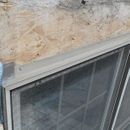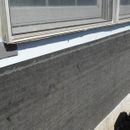$26,000 repair and we still have water leaking in
We purchased our home in 2007 (built 2003). In 2016, when having some stonework repaired, we discovered that water had been leaking for years behind our stucco & stonework, and many of the walls of the front of our home were almost completely rotted through! After much confusion and lots of conflicting advice from various contractors, we hired a stucco company to do the repairs. They told us the builder didn’t install flashing on any of the windows of the front of the house, and that the gutter/wall intersection either didn’t have a diverter or it wasn’t installed properly….thus the source of the leaking. The builder (now long out of business) also put in the gutters then stuccoed around them at wall/gutter intersection.
The stucco company in 2016 made the repairs (pics attached of that process..sorry I couldn’t post them all so they may not make sense). Well, fast forward to today. Our daughter’s bedroom window started leaking (despite new windows in 2019). We pulled off dry wall in her room, which is right next to the gutter with the original diverter issue. Lots of wet wood and insulation. We got out our moisture meter and checked the other rooms that were affected in 2016, and sure enough most of the same areas are wet again.
Where do we go from here? Based on the pictures of the repair work, could it still be the windows? We are beyond frustrated and anxious about whether or not the stucco company will honor their warranty….but even more worried that it will still not be resolved after it’s all said and done. Help!!
GBA Detail Library
A collection of one thousand construction details organized by climate and house part












Replies
megnchris,
That must be a very stressful situation. I'm sorry though the it isn't something that can be assessed with any certainty without a site visit. There are a few possibilities: It could be the windows themselves, although if the stucco repair company properly flashed the openings and included a sill-pan, that is unlikely. It could just be that stucco is a reservoir cladding (that is one that takes in and holds water) which when installed without a capillary break can experience moisture problems without any obvious source of leaks. It could still be the flashing.
The potential for problems with stucco is such that it has virtually disappeared in new buildings around here. One solution to consider if future repairs are going to be in the range of the last one, would be to replace it with something more resilient, like a composite siding on a rain-screen.
Edit: I took the photos you posted as being the windows and flashing before the stucco repair took place. If instead they show what they did as remediation it is entirely inadequate. The flanges if the windows need to be covered by flashing tape, and a metal head flashing installed. Those little bits of corner flashing and caulking do next to nothing.
Good luck!
I'm with Malcolm, if those are the "improved" details, they are totally inadequate.
You can post some more pictures but most likely, the stucco has to be redone around there. It would probably be worth while pulling the windows and checking if the rough openings are flashed properly (which is doubtful).
All windows will leak. With good details, these small leaks from windows would cause ZERO issues. If window leaks damage your wall, they were not installed properly.
Unfortunately in your case, I doubt it was leaks from the windows, even basic flashing details around the outside of your window are missing.
Meg & Chris,
Did the contractor include an air gap between the stucco and the WRB? You may want to read this article: "To Install Stucco Right, Include an Air Gap."
Martin - I don't know if they included an air gap.....I will ask them about this though. Thank you!
Hi Malcolm & Akos -
Thanks for the replies. The 3 photos I originally posted are during repairs....they may be taken at various stages. I'll try to post more below and explain each. We still think the leaks are coming in around the windows. The windows themselves aren't leaking....I've had the poor guy out twice to double check. :( I know this isn't really diagnosable without checking things out here on site. We decided to hire a structural engineer to come look at the repairs and/or the window framing. If you have other any suggestions, we're all ears!
I can't attach many pics at a time so I'll post a reply with pics to describe. The one attached here is BEFORE any repairs were made in 2016. Would it be evident from the outside (ie, this picture) whether or not flashing is present? We're wondering if the inspector should have noticed that it was missing.
These pics are above our formal living room's windows, and below them, during the repair process. The pics with the small metal plates that are super caulked into place are pics of the repaired work. I don't know that I have pics of every step, so there could be more that was done before things were finished.
I believe these are our dining room windows. First and second are before any repair. , next (hard to see b/c dark pic) but they added the metal plate thing w/ lots of caulking, last pic has flashing tape. In that last pic, it looks like they did add something (beige lip over the top of the window) but not sure what it's called.
I'm not a stucco guy, I've only ever had to deal with EIFS here, so not an expert by any means.
Just looking at the picutres, I'm not surprised the original stucco finish failed. The caulked on head flashing above the trim is next to useless.
As for the repairs, quick googling of what the details should look like:
https://www.awcitechnologycenter.org/content/exterior-system-details-stucco
The above includes exterior insulation, but it is exactly the same details without it.
Important items are:
-TWO layers of WRB under the stucco (even better drainage gap as per Martin's link)
-head flashing with weeps above the windows, this should be lapped by the WRB above the window
-flex flashing over sloped sill inside the rough opening lapped over WRB bellow the window
-nail fins on side of windows taped to WRB
-WRB bellow window tucked under window flange and taped to window flange
-metal window sill pan out past the stucco finish
If any of these details are missing, chances are the wall will fail again.
Most likely Malcolm's suggestion of replacing it with more robust siding is probably cheaper than fixing this.
Thanks Akos for the detail! At this point we are seriously considering doing siding instead of stucco on the front of the house. Would it really fix the leaking though if there are problems with the window flashing and/or the original window framing installed by the builder? Or just that getting all of the stucco off, they could see for sure what's happening with the window frames and make any repairs if needed before putting up siding? We're looking at hiring a structural engineer to come to our home to help us figure out what exactly is leaking. Sigh.
Generally rough openings not detailed well are 20 year type of problem, eventually the sill will rot. Unless you have major window leaks, it won't cause the amount of damage in your pictures. I wouldn't remove siding and window to fix it, but if everything is out, it would be worth it for the peace of mind.
If the interior finish is removed for the repair, it should not be a problem to pull the window, flash the rough opening properly and re-install before the new cladding goes on.
Unfortunately, I commonly see this around major renovations. The exterior finish looks great, but missing water management details underneath. They are very expensive to add in after the wall fails.
This is what properly flashed windows should look like:
https://www.finehomebuilding.com/2008/07/03/installing-and-flashing-windows-correctly
Siding, provided the WRB is installed properly, is harder to mess up. Stucco does work, but there are a couple of details that MUST be followed when installed over wood framed wall.
Update - stucco company came out today to do water testing...seems like the water is getting in through cracks between the old (fiber mud) stucco and their new (better quality) stucco. They tell me 50-50 chance of it cracking bc they don't bond well. They want to seal cracks with something called Mor-flex then retest to see if it still leaks. Thoughts? Suggestions?
All stucco will leak water, you can never have it sealed up enough. There will always be another crack. The goal of good stucco install is to have proper details and solid WRB behind that allows for this water to dry/drain without getting into your wall.
So the caulk might fix some of the issue, but it won't resolve the underlying issues. Hairline cracks through stucco should never cause a wall to fail.
Akos, thanks for your reply. I wouldn't think the cracks would be the issue either, but the water definitely dripped into the wall while they did it (we removed drywall in affected areas). The rest of the house has stucco and we aren't having problems anywhere else so I just can't believe there isn't something more than just cracks! Not sure what to believe anymore ☹️
All siding leaks, the goal of WRB and flashing is that those leaks don't make it into the structure. So if you are spraying water on the siding and it is making it into the building, water management details are bad. It doesn't matter if this is brick,stucco or wood.
Since any real repair means major work and cost, trying a band aid is worth it. To make sure the issue is fixed, it would be good to not finish the interior drywall completely, just hang it with a couple of screws so you are not looking at rough framing. This way it is easy to open the wall after a couple of months and check for water. Unfortunately this won't guarantee that another crack that forms a couple of years down the road does not cause the same issue again.